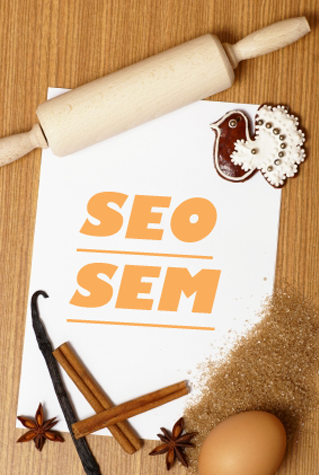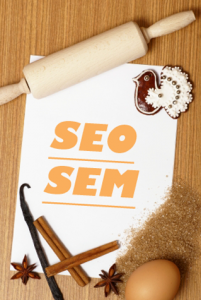
As soon as it’s cold enough outside that chocolate gingerbread cookies won’t melt, they start turning up in supermarkets by the truckload. And now, we’re here – Christmas is just around the corner. Well… not quite. But Santa will be here in less than three months, which leads me to ask, “is everything prepared for the SEO side of the season?” No? Then it’s high time!
Today, we’ll deal with how to approach predictable and recurring events from an SEO point-of-view. Even if it’s a little late to implement a few of these measures for this Christmas, we can be sure that it will all happen again next year anyway. And the same goes for the Easter Bunny, Valentine’s Day, Oktoberfest, school holidays, etc…
So, ‘predictive SEO’ for predictable events – what’s the point?
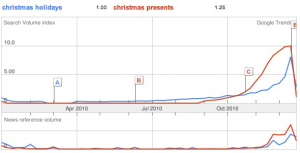
Naturally, Christmas promises to bring extra traffic to sites with Christmas cookie recipes and Kris Kringle craft instructions. This is assuming, of course, that these and similar keywords are actually ranking well at this time – and at precisely this time. Otherwise, as usual, stocks of Christmas candles, children’s toys and cigar boxes will be greatly reduced through online-ordering and revenue from gift vouchers will rise significantly. And, there is one other holiday opportunity that shouldn’t be missed – fresh links. But more on this later.
More traffic, more sales – but how do you make it happen?
First up in our overview: the seven sensible steps for successfully planning ‘predictive SEO.’

1. Early Planning
Now is not the time to leap without looking first. If you are already thinking about how you want to earn your Christmas money at the start of fall then you’re on the right track. To be successful, we need to consider the following info and conditions:
- Who’s involved?
- How much effort should we expend and what’s our budget?
- What are our deadlines?
- Are there conditions that need to be clarified? (e.g. particular marketing campaigns, newsletters, claims etc.)
- What experience have we gained from previous years?
- And, of course, what are the right keywords?
2. Target Analysis
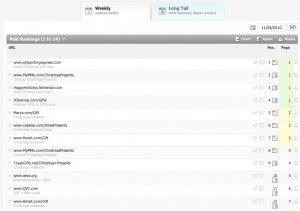
Which (sub)pages should we focus on and develop? Existing sites that already have good Google rankings for a keyword are ideal. If you have already found several pages from your own domain that rank well for a keyword then you should forward them to the target page via a 301 redirect or at least with a clear keyword link.
A skillfully deployed canonical tag is particularly useful for dealing with pages that are similar to each other. These pages are easiest to find when you are already monitoring your domain keywords via Searchmetrics Suite.
Who will be your strongest competition? It won’t necessarily be the pages that currently hold the best positions for the desired keywords. It’s worth your while to look back a few months using the Searchmetrics Tools Keyword Research. Who ranked well for ‘Christmas’ around December 19th 2010? You can see how the site looked back then using archive.org. All of this is useful for competitor analysis…
3. Building (or refreshing) appropriate content
Just like users, search engines want to find the most current content for a specific date. For this reason, selected pages should be updated at least twice: A couple of days or weeks before the event (‘St. Nicholas update’?) to remind Google that something is happening, and then once more just before the targeted date. And of course, it is always helpful to keep the page up-to-date on a daily basis throughout the ‘active’ phase of the campaign. Content is freshness is king…
In building content, you should also also be careful not to forget Universal Search. Are there any images or videos available? You can always rely on fresh results with news, but that only works when you’re already a publisher. For most sites, this isn’t really an option.
4. Link Structure
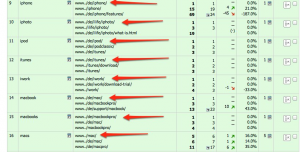
The linking of current content and (internal as well as external) backlinks is always a rewarding strategy and new content is always a good reason to direct link structures to target pages.
Of course, the old rule of ‘the more links, the better’ still generally applies. The refined version simply states that you should make sure the links are as varied as possible and come from thematically relevant areas. Either way, you can’t ignore homepage links. Ideally, of course, it is always best to include ‘Specials’ in navigation bars along with text from relevant pages.
5. Powerful Buzz for the Big Day
Timing is critical. It’s not just about getting as many tweets, likes or blogposts as possible – it’s about getting the most in the shortest amount of time and, above all, at the right time! For this, we can refer to the methods that we are already familiar with – i.e. competitions, press releases, Google News, mail-outs and social media.
With that said, the success or failure of the entire project depends on planning. But good planning is nothing without communication. Ideally, you should already have a good name among the various market players. If you do, then it’s worth your while to notify journalists by mail or phone. And don’t forget – bloggers are people too and generally appreciate being contacted directly.
6. Clean the page up again
As always, once the shopping season has passed – that is between Christmas and the New Year – you should make sure to collect and archive the relevant pages. This should be done properly and with more than just a few links so that no one will accidentally land on old content in the New Year.
Besides this, all specially set links and canonical tags should be reset and rebuilt with the next campaign in mind. You may also need to rebuild navigation menus. Yup, that’s right – everything has to be taken care of.
7. Analysis and Documentation
What worked? What didn’t? At the end of the holiday season, you should collect all the preparations, planning, used pages, links and buzz tools etc. in one file and save it somewhere. There are two reasons for this. First, it will be within easy reach at the end of next summer, and second, it won’t be long until April and Easter roll around.
And how exactly do you include link building in all of this?
At the beginning of this post, I promised to talk a little about this topic. The early realization that Christmas is on its way is particularly useful if extra links are built in time. But, how do we do this exactly?
Behind this entire strategy lies the recognition that you are likely not the only one who wants to profit from Christmas and the New Year. And, if you look at the above list again, you might notice a particularly labor intensive point – namely, the creation of relevant content.
- For example, there will be thousands of pages trying to write about Christmas gift trends but only a few of these will identify and reveal these trends. Others will then link to these posts – heavily. Anyone who isn’t already the size of Otto.de or Amazon can make a press release about these kinds of gift trends. Perhaps you can group a few trend studies together and provide high-value analysis for the very people who should be linking to you – other site operators.
- Or another example: has anyone collected the dates of all the regional Christmas Markets together in one attractive map? This takes a bit of effort but costs less than many other link-building projects.
- Or yet another example: what are the rights and obligations for exchanging gifts purchased online? Or, or, or… Most importantly, a topic should already be ‘deep’ enough to warrant a link after a quick look.
This will give the impression of a credible source and create a certain social media buzz that will hopefully grab the target audience (i.e. the blogger or web editor) with attractive tables and graphs. The more original, professional and comprehensive the content is, the easier this will be.
The most important condition is timing. Any of these examples above should already be available by the time others are in the content design and planning phases for their pages. So, pay attention: if you’re looking forward to finding a few link gifts under the tree this year, then you have to think about Christmas before your competitors.
